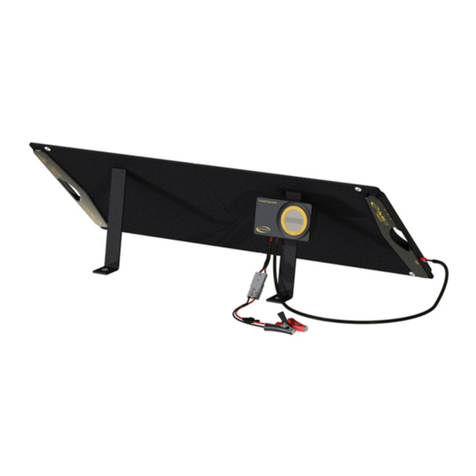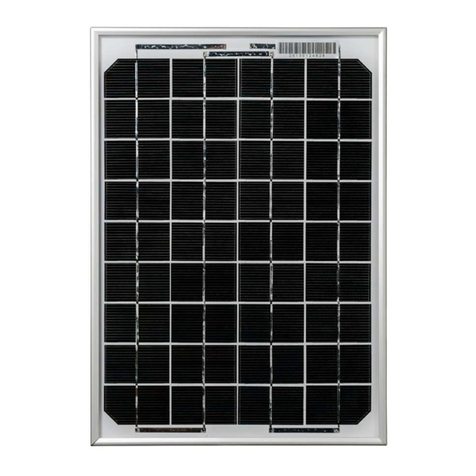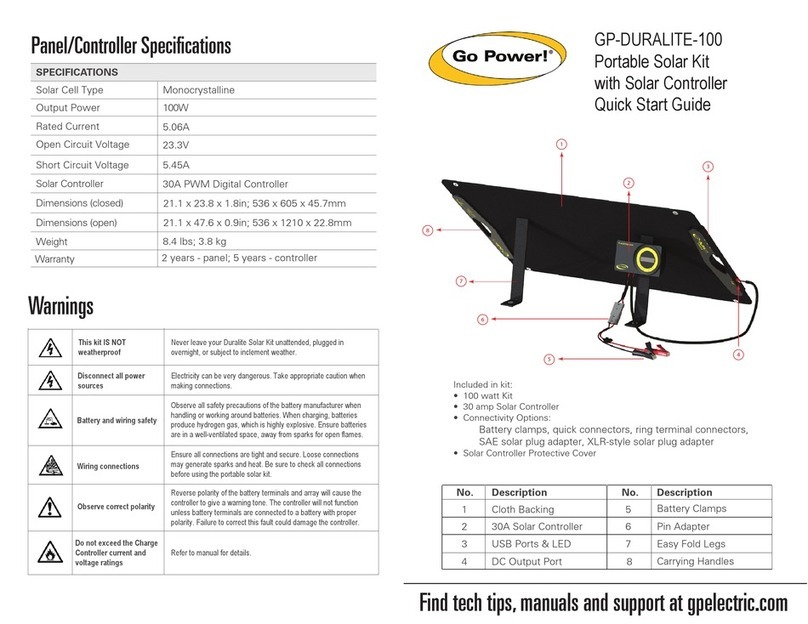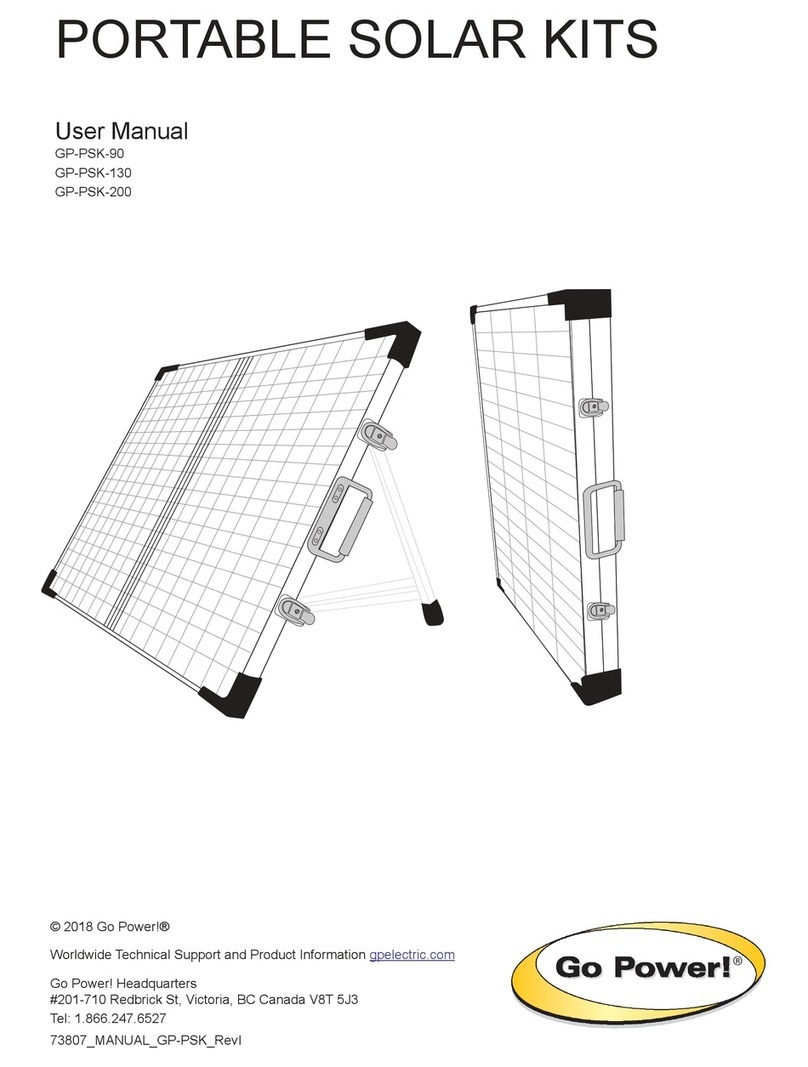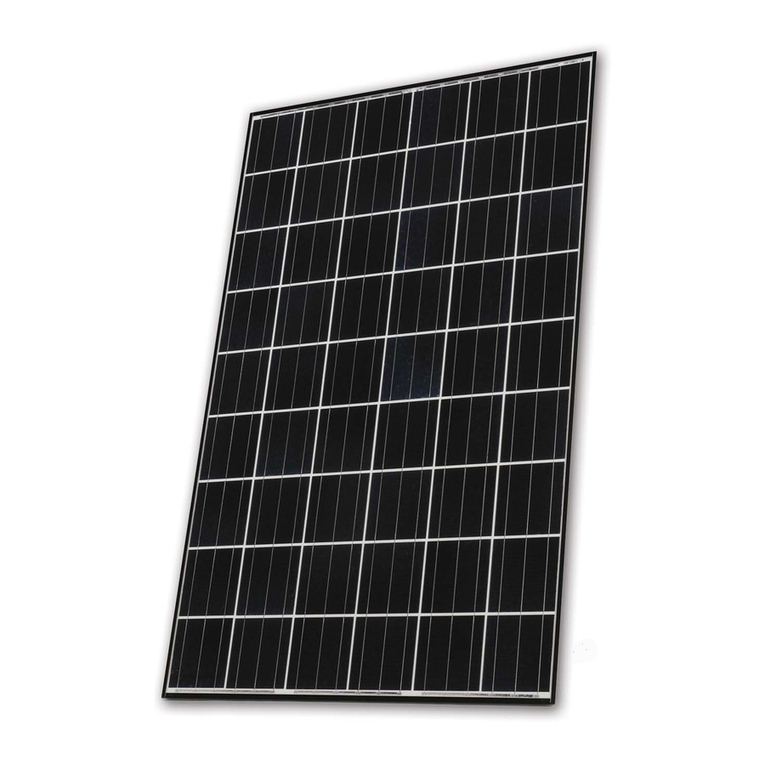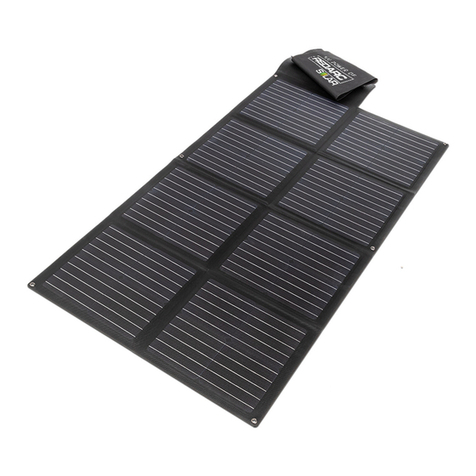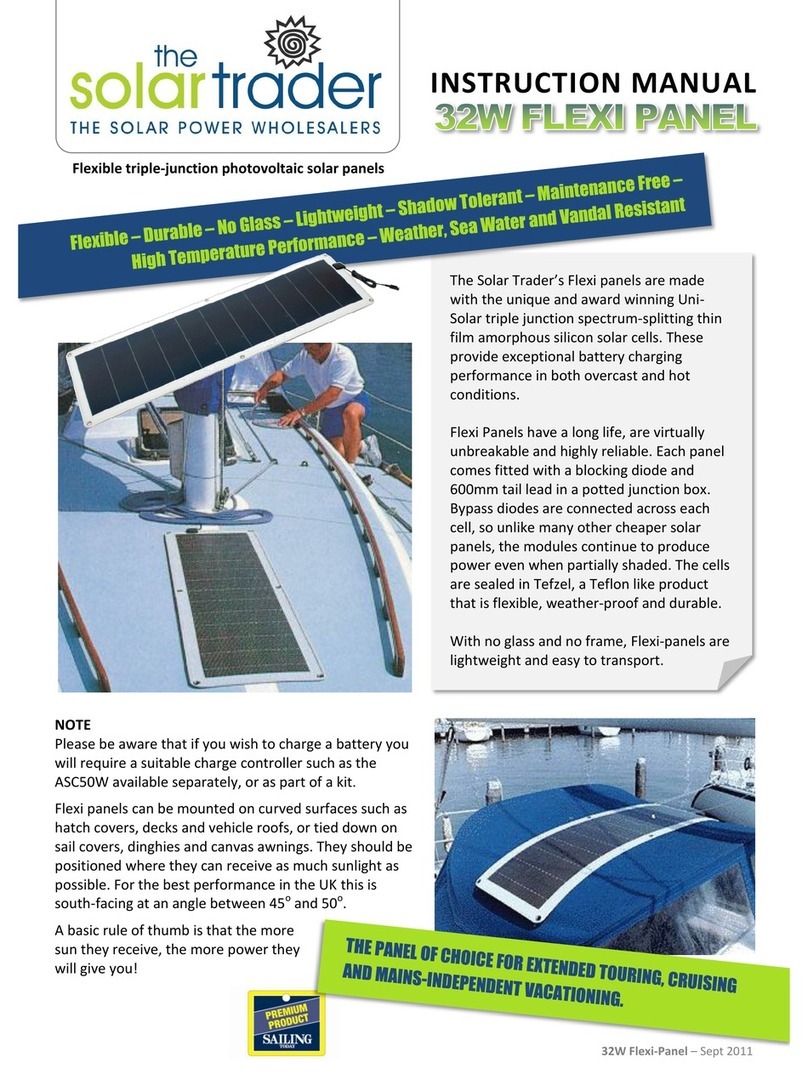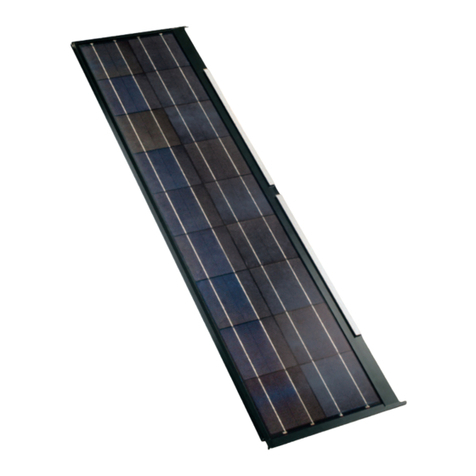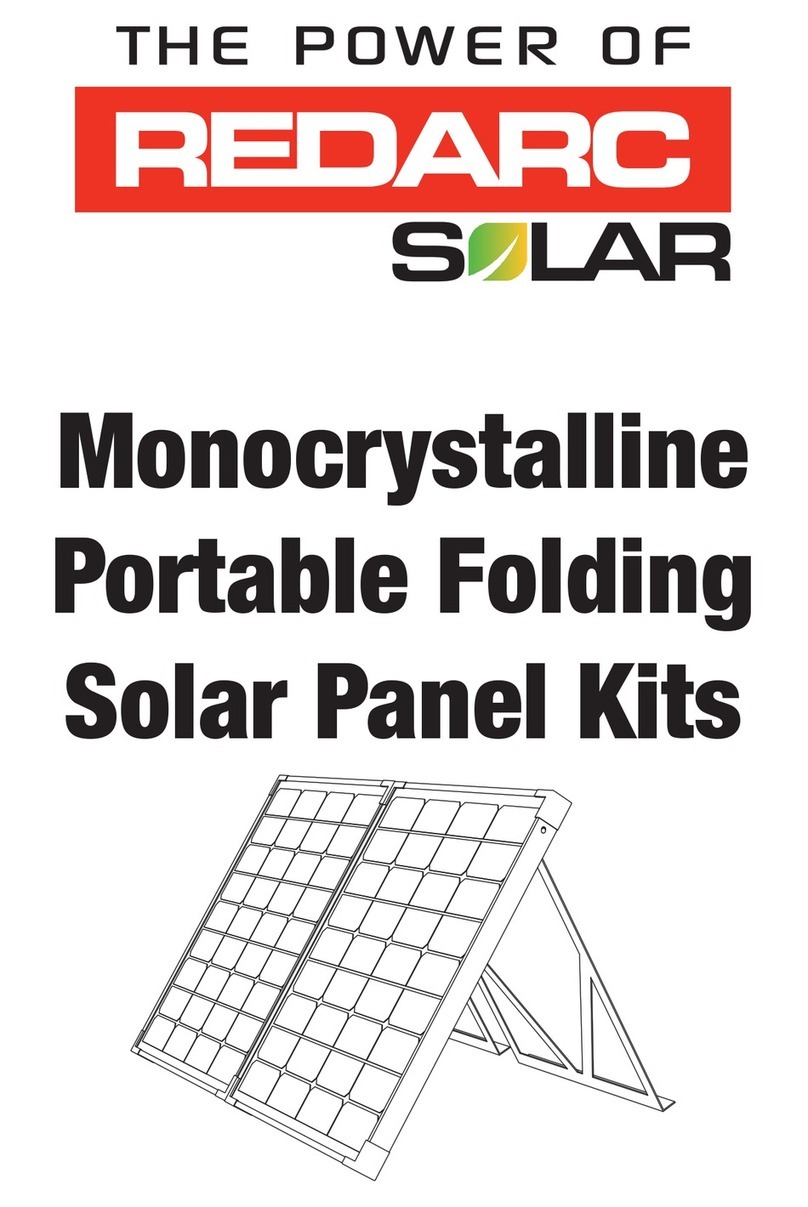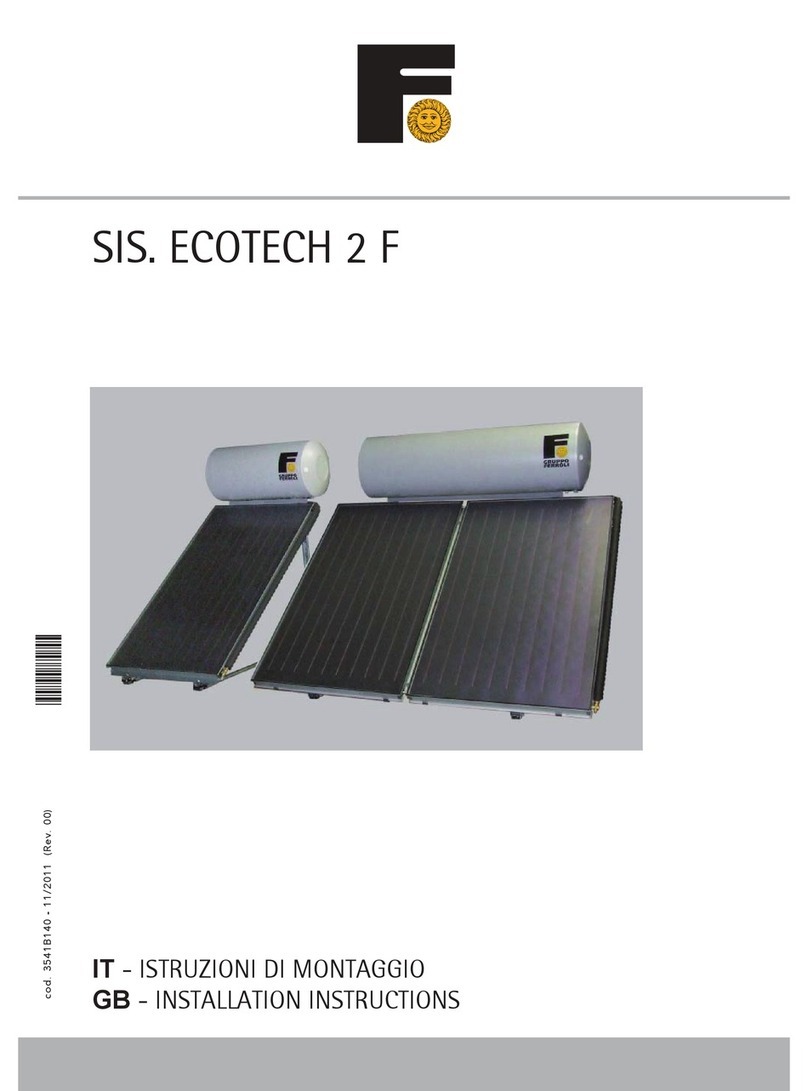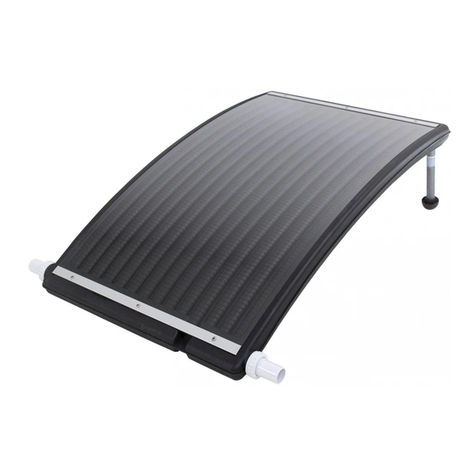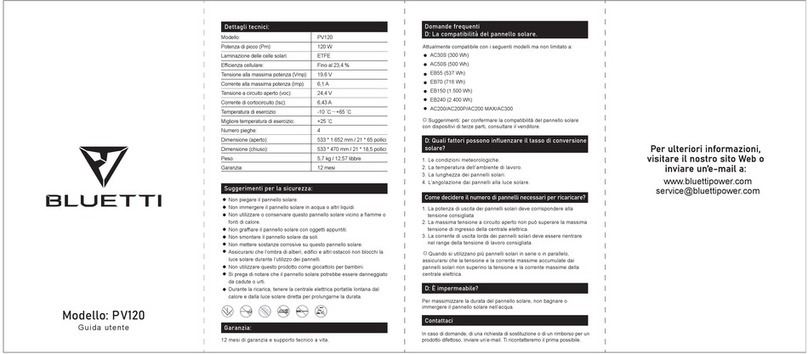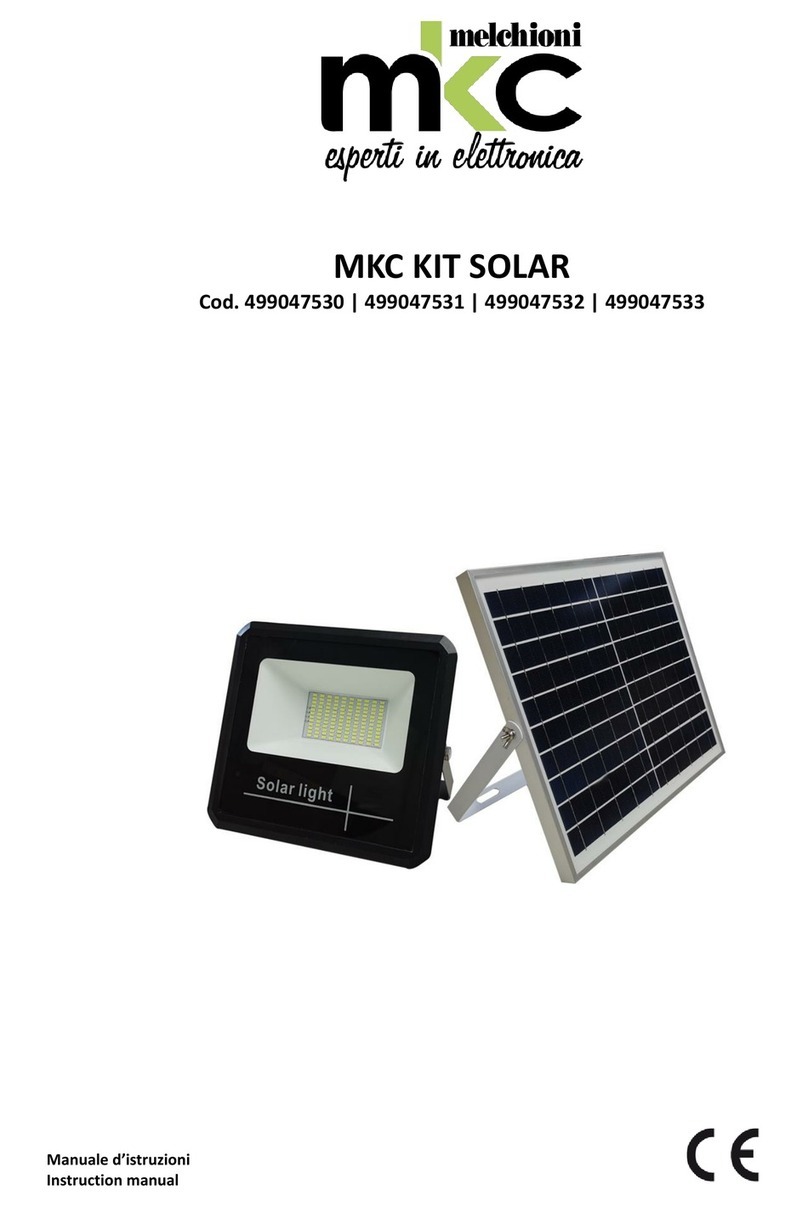Go Power GP-FLEX-100 User manual

Owner’s Manual
powered by
®
GP-FLEX-100
GP-FLEX-200
GP-FLEX-100E
GP-FLEX-100
TM
Solar Flex

2gpelectric.com
GP-FLEX-100
GP-FLEX-200
GP-FLEX-100E
1.0 General Information 2
1.1 How Does a Go Power! Solar Charging Kit Work? 3
1.2 Warnings 3
1.3 Required Tools 3
1.4 Parts Checklist 4
1.5 Module Specications 4
2.0 Wiring Modules with MC4 Cables 5
2.1 Installling your 100 watt Solar FlexTM Kit (GP-FLEX-100) 5
2.2 Installing your 200 watt Solar FlexTM Kit (GP-FLEX-200) 5
2.3 Adding a 100 watt Solar FlexTM Expansion Kit (GP-FLEX-100E) 5
3.0 Routing Power Cable through the Fridge Vent 5
3.1 Method 1 – Hole in Side of Vent 5
3.2 Method 2 – Through Screen Grid 5
4.0 Mounting the Solar Module 5
5.0 Installing The GP-PWM Controller 5
5.1 Mounting The GP-PWM Controller 6
6.0 Connecting to the Battery & Solar Array 6
6.1 Typical Battery Connection 6
7.0 Limited Warranty 6
7.1 General Warranty Information 7
7.2 Warranty Return Procedure 7
7.3 Additional Information 7
7.4 Out of Warranty Items 7
8.0 Diagrams 7
1.0 General Information
Congratulations on purchasing your Go Power! Solar FlexTM Kit. You have chosen a clean, quiet and sustainable power source. Go Power!
Solar Charging Kits allow you to enjoy the luxuries that electricity provides, without hooking up to shore power, by keeping your batteries
charged. For simple battery maintenance to full-time live-aboard power, Go Power! Solar Kits are available in a variety of sizes and can
be installed on RVs, boats, campers, trailers, fth wheels, motor homes, cottages/cabins, long-haul trucks and industrial applications. This
manual is geared towards RV installation. For other applications, please consult a certied electrician or contact Go Power! Technical Support.
Information in this manual is subject to change, please visit gpelectric.com for the most current version of this manual.
Table of Contents
Note: Solar Flex Modules have a 30° maximum recommended bend - 2.7” / 69mm bend (100 watt module)

3
gpelectric.com
GP-FLEX-100
GP-FLEX-200
GP-FLEX-100E
1.1 How Does a Go Power! Solar Charging Kit Work?
The solar module converts the sun’s energy into DC electricity and this electricity charges the battery. The battery stores the electricity, similar to a water tank
storing water. The battery power may be used at any time to operate devices connected to the battery. To stop the battery from being overcharged by the
solar module, a solar controller is connected in between the solar module and the battery. The GP-PWM-30 controller will disconnect power from the solar
module when the battery is fully charged.
Please read and understand all instructions before installing your new product for the easiest and safest installation. Before installing the kit, please review
all diagrams included in this manual. If you have any doubts as to this kit’s compatibility with your RV, please contact your authorized Go Power! Dealer. It is
advisable to retain this manual for future reference.
1.2 Warnings
Disconnect all power
sources before
attempting installation
Electricity can be very dangerous. Installation should be performed only by a licensed
electrician or qualied personnel.
Solar module saftey
Photovoltaic modules generate DC electricity when exposed to sunlight or other light sources. Contact with the
electrically active parts of the module, such as terminals, can result in burns, sparks and lethal shock whether
the module is connected or disconnected.
When modules are connected in parallel, amperages are additive. Consequently, a system assembled from
photovoltaic modules can produce high amperages, which constitute an increased hazard. Do not touch
terminals while module is exposed to light. Cover the module face completely with opaque material to halt the
production of electricity when installing or working with modules or wiring.
Battery and wiring
safety
Observe all safety precautions of the battery manufacturer when handling or working around batteries.
When charging, batteries produce hydrogen gas, which is highly explosive. Work in a well ventilated area
and use caution when making or removing electrical connections. Ensure wires are disconnected from their
power sources when wiring. Do not expose battery to open ame, cigarettes or sparks. Shield skin and eyes
from battery acid.
Ensure all connections are tight and secure. Loose connections may generate sparks and heat. Be sure to
check connections one week after installation to ensure they are still tight.
Work safely Wear protective eyewear and appropriate clothing during installation. Use extreme caution when working
with electricity and when handling and working around batteries. Use properly insulated tools only.
Observe correct polarity
at all times
Reverse polarity of the battery terminals will cause the controller to give a warning tone. Reverse
connection of the array will not cause an alarm but the controller will not function. Failure to correct this fault
could damage the controller.
Do not exceed the
voltage and current
ratings of the
GP-PWM-30 Controller
The total current of the solar system is the sum of the short circuit current of the solar modules in parallel,
multiplied by a safety factor of 1.25. The resulting system current is not to exceed the amperage rating of the
controller. The voltage of the array is the rated open circuit voltage of the solar modules and is not to exceed
28 volts for a 12 volt system.
The current rating of the solar system is the sum of the Maximum Power Current (Imp) of the solar PV
strings in parallel. The resulting system Imp current is not to exceed 30A. If your solar system exceeds
these ratings, contact your dealer for a suitable controller alternative.
g
1.3 Required Tools (Additional tools may be required)
a. Phillips Screwdriver
b. Keyhole Saw
c. Pencil or Marker
d. Pliers
e. Wire Strippers
f. Wire Crimpers
g. Electric Hand Drill
h. 1/16 and 3/8 inch Drill Bit
i. 5/16 and 7/16 inch Wrench
j. Sealant
Note:
This installation guide does not list all possible variations of available solar modules. This installation guide will address
the assembly of Go Power! Solar FlexTM Kits, which contain one, or more solar modules connected in parallel for a 12 volt
system. Expansion Kits are available to add solar modules to an existing system.

4gpelectric.com
GP-FLEX-100
GP-FLEX-200
GP-FLEX-100E
PART
01. Ring Terminal Battery Connector
02. 50’ MC4 Cable with Male and Female MC4 Connectors
03. Tie Wrap
04. Positive (male) MC4 Parallel Branch Connector
05. Negative (female) MC4 Parallel Branch Connector
06. #10 x 1” Wood Screws
07. #10 x 1.5” Machine Screws
08. #10 Well Nuts
09. #10 Lock Washers
10. #10 Flat Washers
11. 3/8” Plastic Cable Clamps
12. #8 Screws for Cable Clamps
13. Fuse Holder Inline with 30A Fuse
14. Solar Flex Module
15. GP-PWM-30 Controller
1.4 Parts Checklist
GP-FLEX-100 GP-FLEX-200 GP-FLEX-100E
2
1
6
0
0
6
6
6
6
6
6
6
1
1
1
2
1
6
1
1
12
12
12
12
12
12
12
2
2
1
0
1
6
1
1
6
6
6
6
6
6
6
1
1
0
SPECIFICATIONS GP-FLEX-100 & 100E GP-FLEX-200
Cell type Monocrystalline Monocrystalline
Rated power (Pm) 100W 200W (2 x 100 watt panels)
Maximum power voltage (Vmp) 17.8V 17.8V
Maximum power current (Imp) 5.62A 11.24A
Open circuit voltage (Voc) 20.8V 20.8V
Short circuit current (Isc) 6.01A 6.01A
Voltage coefcient –60.8mV / °C -60.8mV / °C
Power coefcient –0.38% / °C -0.38% / °C
Current coefcient –2.2mA / °C -2.2mA / °C
Module efciency 19.9% 19.9%
Maximum system voltage 600VDC 600VDC
Series fuse rating 10A 10A
Weight 2.9 lb (1.35 kg) 5.98 lb total (2.7 kg)
Dimensions 41.7 x 21.3 x 0.1 in / 1060 x 540 x 3 mm 41.7 x 21.3 x 0.1 in / 060 x 540 x 3 mm (x2)
Frame type / material Laminated TPT backsheet, includes aluminum grommets
Max power tolerance +/- 5%
Power Specications calculated
at STC:
• Irradiance: 1000 W/m2
• Cell Temperature: 77 °F (25 °C)
• Air Mass: 1.5
Specications are subject to
change
1.5 Module Specications
01 03
06 11
07 08 09 10
04 0502 14
16
Battery (not included)
30
12 13

5
gpelectric.com
GP-FLEX-100
GP-FLEX-200
GP-FLEX-100E
2.0 Wiring Modules with MC4 Cables
Solar Kits with MC4 cables contain a potted or sealed junction box with a positive and negative MC4
connector. This is referred to as an MC4 junction box. MC4 connectors are either positive or negative and
each connector has its polarity symbol embossed close to the connection point. To extend a cable from an
MC4 junction box, a polarity opposite connector must be used. E.G. a negative connector must plug into
a positive connector in order to extend it. Please remember, the polarity of an MC4 cable wire run is the
polarity symbol on the connector closest to the MC4 junction box. It is advisable to attach a polarity sticker to
the positive extension cable in order to avoid confusion during installation.
2.1 Installing your 100 watt Solar FlexTM Kit (GP-FLEX-100)
Solar Kits containing a single module with MC4 cables will be equipped with a single 50’ MC4 power cable that has
both a male and female MC4 connection. This cable is meant to be cut in half leaving you with a 25’ cable with a
male MC4 and a 25’ cable with a female MC4 connection. Refer to Diagram-1, “MC4 Power Cables for RV Kits.”
2.2 Installing your 200 watt Solar FlexTM Kit (GP-FLEX-200)
Solar Kits containing two modules with MC4 cables will be equipped with a 50’ MC4 power cable, a negative MC4
parallel branch connector and a positive MC4 parallel branch connector. Refer to Diagram-2, “Wiring Parallel
Modules with MC4 Cables.”
2.3 Adding a 100 watt Solar FlexTM Expansion Kit (GP-FLEX-100E)
Solar Expansion Kits containing a single module with MC4 cables will be equipped with a 50’ MC4 power cable,
a negative MC4 parallel connector and a positive MC4 parallel connector. Refer to Diagram-2, “Wiring Parallel
Modules with MC4 Cables.”
3.0 Routing Power Cable through the Fridge Vent
Locate the refrigerator vent on the roof of the RV. Remove vent cover to gain access to the duct opening. Refer
to Figure 1. Retain vent-fastening hardware.
3.1 Method 1 – Hole in Side of Vent
Drill a hole through the side of the vent (5/8” hole). Insert a rubber grommet (not included) into the hole. Insert the
power cable (already wired to the solar module) through the hole and carefully route it to the battery. Be certain
to leave enough slack to allow cable routing from module to vent along desired path.
3.2 Method 2 – Through Screen Grid
1. Thread power cable (already wired to solar module) carefully through the screen and into opening. Enlarge
screen grid hole if necessary.
2. Avoid strapping the power cable to existing wire between the module and the battery. Allowing a few inches
of space between the power cable and existing wire will lessen the chance of voltage loss through thermal
conduction. Use cable clamps with the #8 self-tapping screws and/or tie wraps every few feet along RV roof
and interior route to battery.
3. Ensure all penetrations into the RV roof are watertight. Use an appropriate sealant as recommended by your
RV Dealer to seal holes wherever necessary.
4. Replace vent cover.
4.0 Mounting the Solar Module
The solar modules may be horizontally mounted to the roof using the included screws or an adhesive sealant.
Please contact your RV manufacturer for specications on an appropriate adhesive. Panels are not recommended
to bend beyond 30° (for 100 watt modules 30° = 2.7” / 69mm bend )
Warning: Using an adhesive can create a permanent mounting situation. It is strongly advised that
placement is well thought out and that panel function has been tested before mounting. Go Power! and
Carmanah Technologies is not responsible for damage caused the by removal of Solar FlexTM modules.
5.0 Installing The GP-PWM-30 Solar Controller
The GP-PWM-30 is included in all Go Power! Solar FlexTM Kits mentioned in this manual, except for the
GP-FLEX-100E Expansion Kit.
The GP-PWM-30 protects the battery from overcharging. Acondensed version of the installation instructions appear
below. Please read the full installation manual included with the GP-PWM-30 Solar Controller before installing.
1. Disconnect or cover the solar modules and disconnect the batteries before
commencing the GP-PWM-30 wiring.
Caution:
The vent screen may have sharp
edges or burrs.
Figure 1
Vent
Screen
Refrigerator
Vent Cover
Solar
Module
Cable
Clamps
Method 2
Method 1

6gpelectric.com
GP-FLEX-100
GP-FLEX-200
GP-FLEX-100E
2. Run the solar module power cable to the location of The GP-PWM-30. Do not connect the wires
to the controller or the batteries. Identify the polarity of the wires located on the battery and
solar module (positive and negative). Use coloured tape or mark wire ends with tags. Contacting
the leads of the controller in reverse polarity, however brief, will cause the controller to go into lock
out mode and the solar controller will need to be reset.
3. Kits include a fuse holder with an inline 30A fuse to protect the wire between the battery and solar
controller. Install your inline fuse as close to the battery as possible before connecting the solar
controller to the battery terminal. See Figure 2: “12 Volt Battery Connected to Solar Controller with
Inline Fuse”.
4. Wire the controller according to the terminal identication on the back of controller, starting with the
battery connections. Tighten the positive and negative battery connections and then set the battery
type (see controller manual for instruction). Then, connect and tighten the positive and negative solar
module connections.
5.1 Mounting The GP-PWM-30 Controller
The GP-PWM-30 should be mounted in a location relatively close to the battery, but easily seen for
monitoring system operation. Wires must be run from the solar module to the controller and then to the
battery. The GP-PWM-30 is designed to be ush mounted on the side of a cabinet or wall where the
wiring can be accessed from the back. Allow two to three inches behind the unit. The controller should
be mounted indoors, in a dry location.
1. Select a suitable location for the installation of the controller. Run the power cable from the solar
module to the location selected.
2. Use the template included in the GP-PWM-30 Manual to mark the four mounting holes and the
“cutting line for ush mounting”. Drill the mounting holes. Use a keyhole or jig saw to cut along the
rectangular outline you marked.
3. Wire the controller as shown in the GP-PWM-30 Manual. Use the leftover power cable to connect
the controller to the batteries.
4. Mount the controller to the wall using the four screws provided in the GP-PWM-30 box. Ensure the
back of the controller is protected from damage by any object.
6.0 Connecting to the Battery & Solar Array
It is recommended to connect directly to the battery wherever possible. You can also connect to the
converter/charger where the battery positive and negative wires connect to the converter.
1. Clean all corrosion from battery terminals before proceeding. Crimp ring terminals onto the negative
and positive wires of the power cable to be attached to the battery.
2. Attach the negative (black) wire’s 3/8” ring terminal to the RV battery. Check all electrical connections
and apply a protective coating to battery terminals.
6.1 Typical Battery Connection
1. Single 12 Volt battery connection (See Figure 3)
2. Parallel 12 Volt battery connection (See Figure 4)
3. 2 x 6 Volt series battery connection (See Figure 5)
7.0 Disclaimer of Liability & Warranty
1. Go Power! warrants the Solar FlexTM Kit for a period of one (1) year from the date of shipment from
its factory. This warranty is valid against defects in materials and workmanship for the one (1) year
warranty period. It is not valid against defects resulting from, but not limited to:
• Misuse and/or abuse, neglect, or accident
• Exceeding the unit’s design limits
• Improper installation, including, but not limited to, improper environmental protection and
improper hook-up
• Acts of God, including lightning, oods, earthquakes, re, and high winds
• Damage in handling, including damage encountered during shipment
2. This warranty shall be considered void if the warranted product is in any way opened or altered. The
warranty will be void if any eyelet, rivets, or other fasteners used to seal the unit are removed or
altered, or if the unit’s serial number is in any way removed, altered, replaced, defaced or rendered
illegible.
Figure 3
Single 12 Volt Battery
12 Volt Conguration
Solar
Controller
Negative
Connection
Positive
Connection
Figure 4
Solar
Controller
Positive
Connection
Negative
Connection
Two 12 Volt Batteries
12 Volt Parallel Conguation
Solar
Controller
Figure 5
Positive
Connection
Negative
Connection
Two 6 Volt Batteries
12 Volt Series Conguation
Fuse
Positive
Connection
Negative
Connection
12 Volt Battery Connected to
Solar Controller with Inline Fuse
Figure 2
Solar
Controller

7
gpelectric.com
GP-FLEX-100
GP-FLEX-200
GP-FLEX-100E
3. The one (1) year term of this warranty does not apply to equipment where another limited warranty is available. This may include but is not
limited to, the solar controller ve (5) years and the solar modules ten (10) years (output warranty).
7.1 General Warranty Informtaion
Please visit gpelectric.com for our up-to-date General Warranty Information
7.2 Warranty Return Procedure
Please visit gpelectric.com to read the “frequently asked questions” section of our website to troubleshoot the problem. If trouble persists:
1. Call your Go Power!™ Technical Support team (1-866-247-6527)
2. Return defective product to place of purchase
7.3 Additional Information
Unless approved by Go Power! management, all product shipped collect to Go Power! will be refused. Test items or items that are not under warranty,
or units that are not defective, will be charged a minimum bench charge of ($50.00 US) plus taxes and shipping. A 15% restocking charge will be
applied on goods returned and accepted as “new” stock.
7.4 Out of Warranty Items
Go Power! electronic products are non-repairable, Go Power! does not perform repairs on its products nor does it contract out those repairs to a
third party. Go Power! does not supply schematics or replacement parts for any of its electronic products.
8.0 Diagrams
Diagram 1: MC4 Power Cabels For Solar FlexTM Kits
The MC4 power cable is usually the nal connection between the solar array and the
solar controller. If it has not already been done, cut the MC power cable into two pieces
so that there is a positive conductor cable and negative conductor cable.
1. Cover the solar module(s) with an opaque material. Attach the appropriate MC4 power
cable conductor to the positive and negative connectors of the MC4 junction box. If
you have more than one module, refer to the specic diagram for wiring a parallel MC4
connection.
2. Run the positive and negative MC4 cable conductors from the solar array to the solar
controller. Attach a positive polarity label to the end of the positive conductor. If the
positive conductor needs to be shortened and the polarity label is removed, remember to
re-label it as both positive and negative conductors look exactly the same. Leave a few
feet of cable at the solar controller in case of future adjustment.
Note: solar module junction box and MC4 cables many not be exactly as shown.
Negative MC4
Cable Conductor
Positive MC4
Cable Conductor
Cut 50’ wire in half to
make two 25’ cables
Female (negative) MC4
Junction Box Connection
Male (positive) MC4
Junction Box Connection
Diagram 2: Wiring Parallel (2) Modules with MC4 Parallel Connectors
(GP-FLEX-200, GP-FLEX-100E)
Note: solar module junction box and MC4 cables may not be exactly as shown.
Female (negative) MC4
Parallel Branch Connector
Male (positive) MC4
Parallel Branch Connector
MC4 Extension Cable to Solar Controller or Combiner Box

8gpelectric.com
powered by
®
© 2013 Go Power! By Carmanah Technologies
GP_MAN_Solar Flex_GP-100_200_100E
GP-FLEX-100
GP-FLEX-200
GP-FLEX-100E
This manual suits for next models
2
Table of contents
Other Go Power Solar Panel manuals
Popular Solar Panel manuals by other brands
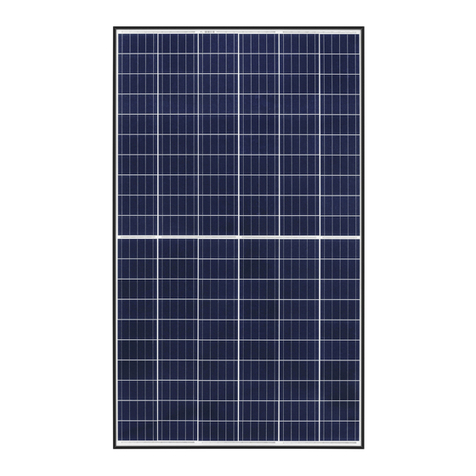
REC
REC TwinPeak 2S Mono 72 Series installation instructions

Hanwha Solar
Hanwha Solar HSL60P6-PC-1-xxx installation guide
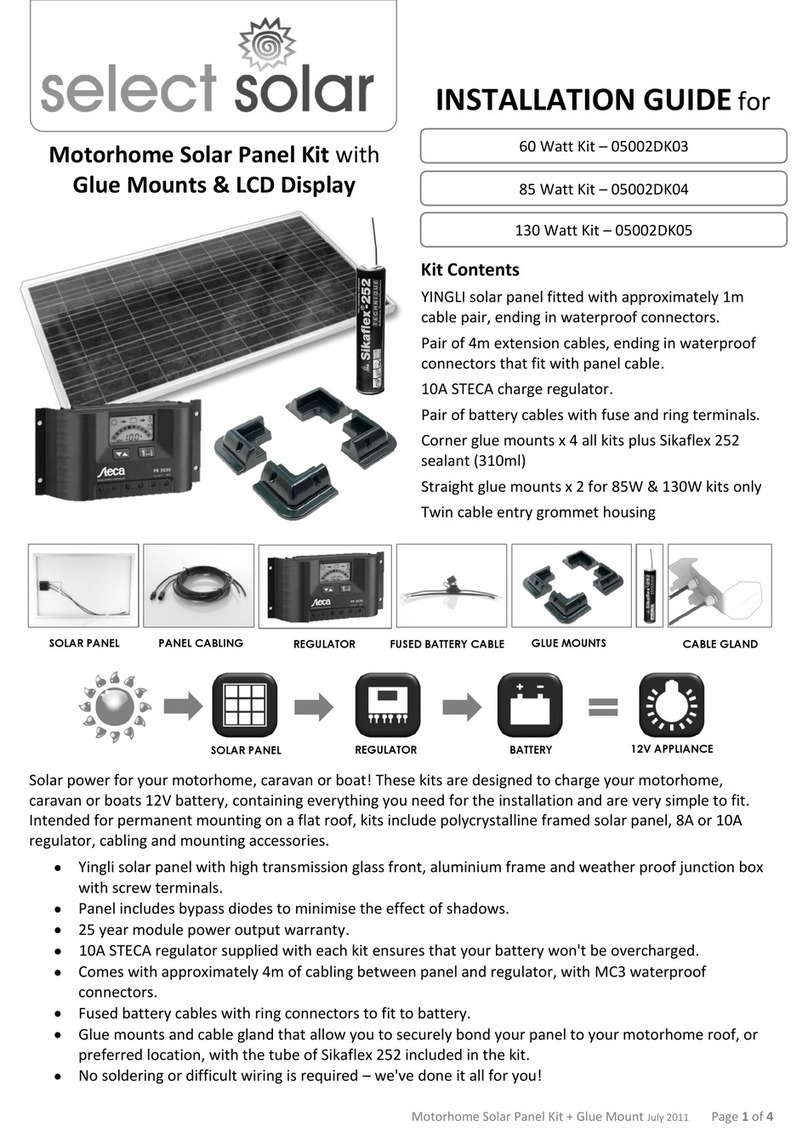
select solar
select solar 05002DK03 installation guide
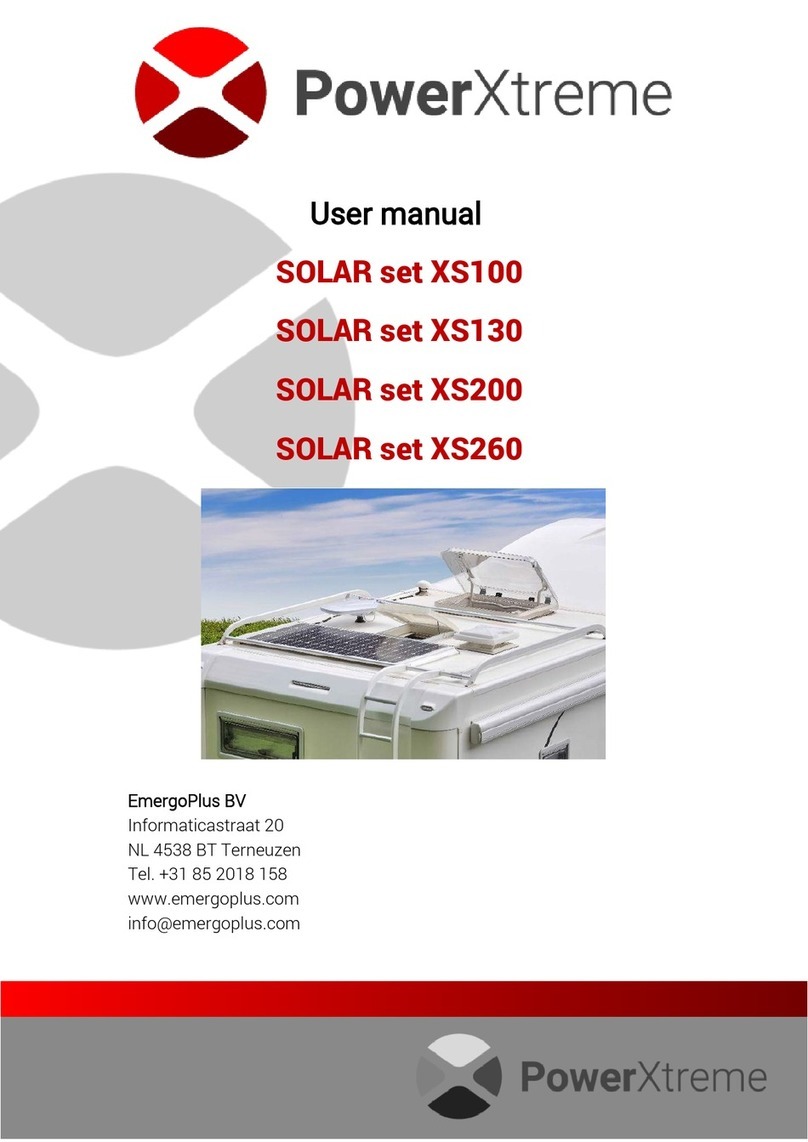
EmergoPlus
EmergoPlus PowerXtreme SOLAR set XS100 user manual
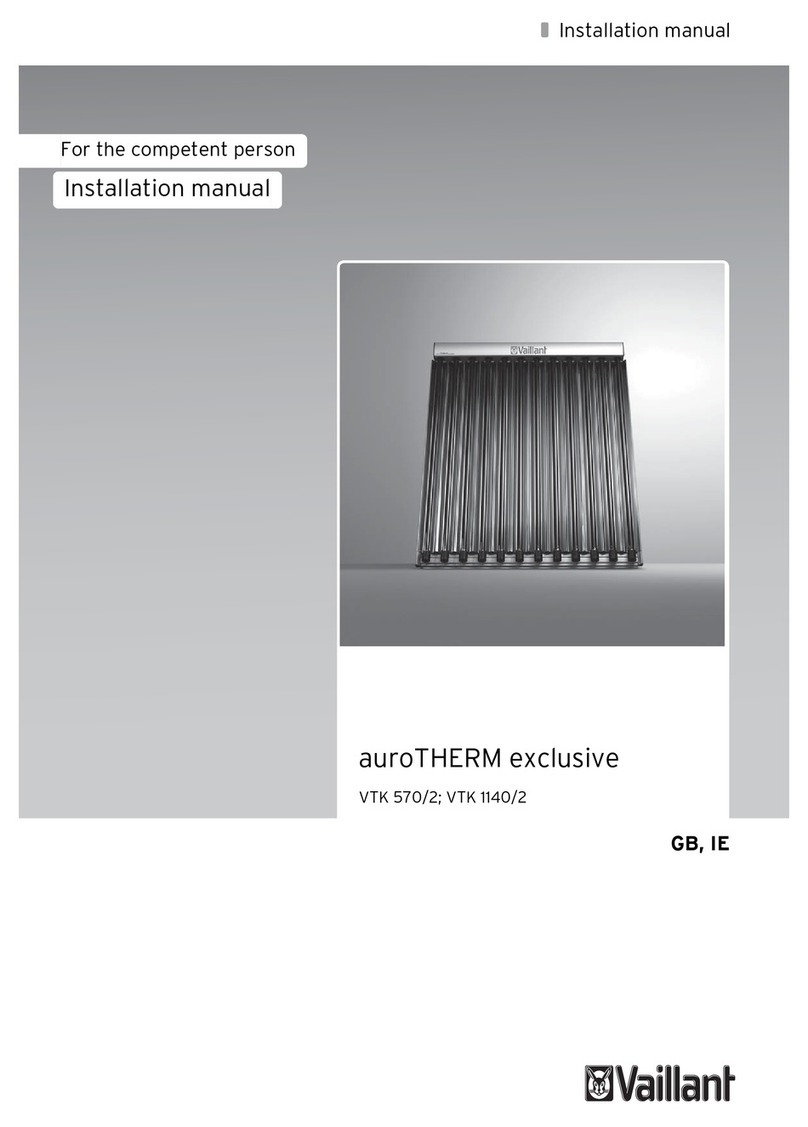
Vaillant
Vaillant auroTHERM exclusive VTK SERIES installation manual

Qcells
Qcells Q.PEAK DUO ML-G9 Plus Installation and operation manual
